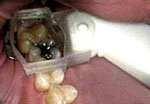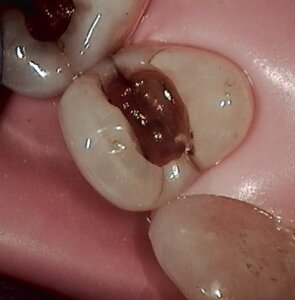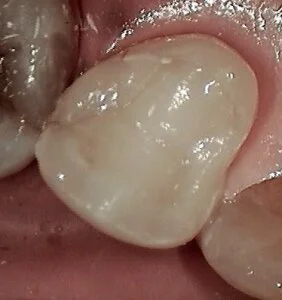Restorative Dentistry
Silver-Mercury Amalgam Fillings
Please note: We have chosen not to perform these in this office.
Silver fillings have been used for over 100 years in dentistry. They provided an easy, economical and long lasting repair for decay. However, they are not natural looking, tend to weaken the tooth, and release small amounts of mercury. The amount of mercury released from fillings is only a small part of the average person’s exposure. Studies have shown no major harmful effects from this mercury release for the average patient, but some patients are more sensitive and the issue is still under investigation. We have never used amalgam fillings at the Elm Tree Clinic.
It is possible to be medically tested for mercury in the body. Certain individuals are very sensitive to tiny amounts of mercury, and there is a test for this as well.
We are happy to work alongside health practitioners in regards to mercury amalgam removal. We can also provide material testing kits to patients if they wish to check for biocompatibility.
If old amalgam fillings are working well, and the patient does not have high mercury levels or experience sensitivity, we do not advise replacement unless requested by the individual or their health practitioner.
Many of the materials used in the past were not able to bond to tooth structure. They served to physically fill holes, but often the decay or the process to place a filling really damaged the integrity of the tooth. Large amalgam fillings can disconnect the cusps of a tooth, and opposing teeth can hammer these weakened cusps like an axe wedge, breaking off cusps and cracking teeth by putting them under tension. We do advise changing old fillings that are compromising the strength of the tooth and are prone to fracture.
If you have fillings which need replacement we offer the latest state-of-the-art restorations.
We take special precautions to minimize our patients exposure to amalgam dust, debris and vapor while removing old fillings. Be sure to see our Office Safety and Environment section for details on how we minimize mercury exposure to our patients and staff.
There is no single replacement for amalgam in all cases. Alternatives are: Resin Fillings; Gold, Porcelain or Resin Inlays and onlays; Full Crowns.
Resin Fillings
For small single surface fillings composite resin is the filling of choice, which look better and perform stronger than amalgam. For medium size fillings between teeth, resin can work well. They look natural, and new materials are lasting well with fairly quick place time.
We now use Admira Fusion silica-ceramic based white fillings, which are not made with Bisphenol-A or Bis-GMA, TED-GMA or UDMA. We also have Bioactive materials we use now for liners and tricky deep areas that not only do not contain harmful monomers but actually release helpful ions such as calcium, phosphorus and silver diamine fluoride (SDF) to prevent further decay. Our ceramic and gold restorations do not contain any plastics of course.
Biomimetic Dentistry
Biomimetic Dentistry is a principle of preserving as much of the natural tooth’s strength and integrity as possible. It also involves using a new generation of bioactive materials that more closely mimic natural tooth properties, and do not contain BPA, BisGMA or other similar chemicals.
When we do Biomimetic dentistry, we only remove the absolute minimum of healthy structure. We rebuild and reinforce the remaining tooth with materials that bond to them and release ions similar to the tooth itself to help harden the tooth and prevent future decay. This is done using engineering principles to keep the tooth under compression, as the natural tooth structure does. We even use Kevlar reinforcement and other materials that can add strength in thin layers. We can use these techniques now for medium to fairly large fillings, with great results.
If a tooth is heavily broken down or heavily filled, resins can be used but inlays or crowns are better choices. Here’s why:
Very large resins are difficult and time-consuming to place. If the filling is very large a crown is the restoration of choice.
Some people are sensitive to the chemicals in resins, even the special biomimetic ones we use.
Inlays and Onlays
Weak damaged tooth with large amalgam.
Amalgam Removed - you can see the cracks and weak thin corners of the tooth left.
Tooth cleaned up.
Biomimetic core built up with bioactive materials, weak corners prepared for ceramic. You can see how much tooth is still preserved.
Finished ceramic onlays.
Onlays can be made to replace medium- large sized fillings in almost any tooth and feel very natural and smooth. They can be made of gold or porcelain, materials which are very stable and biologically neutral. They are more expensive than amalgam or resin initially, but last longer so you do not need to go through the procedure as often in the future. Please be aware that dental insurance usually covers what is cheapest, not necessarily the best, most attractive or strongest option. Insurance may not always cover Onlays or crowns fully. We can provide a pre-treatment estimate for you to define your coverage.
Gold Inlays
Gold inlay fillings have been used for decades.
The lifespan is excellent.
They wear most like natural teeth.
They have the best fit of all for very deep and difficult fillings. They are especially good for the very back teeth.
Porcelain Inlays/Onlays
Porcelain inlays and onlays have a good lifespan.
They appear very natural.
They feel most like natural teeth too, due to their smoothness.
They add strength to the tooth, more than resins do.
Porcelain is very non-reactive and non-allergenic. Some highly sensitive people react least to porcelain.
They are not ideal for very high stress areas.
Medium sized amalgam filling replaced with porcelain inlay.
Full Coverage Crowns
When a tooth is heavily filled, a full crown is needed. Crowns are much stronger and longer lasting than any type of fillings. Crowns can be made in Gold, Porcelain Fused to Metal, or All-Porcelain. Please be aware that dental insurance usually covers what is cheapest, not necessarily the best, most attractive or strongest option. Insurance may not always cover inlays or crowns fully. We can provide a pre-treatment estimate for you to define your coverage. See an example of All-Porcelain Crowns in the images to the left. Before crowns (top) and after (bottom).
Gold crowns wear the most like natural teeth, and have the best fit. They do not look natural, but have an excellent shine. They are the best choice for very high stress situations like the very back teeth.
Porcelain Fused to Metal crowns have a combination of good appearance, high strength and excellent fit. We now have technology to make the edges of these almost invisible so they blend in very well, whereas older types used to have a grey line at the junction. These do involve removing more tooth structure than Porcelain Onlays.
All-Porcelain Crowns have a superb, natural appearance. They are the ideal choice for front teeth, and can work well for selected back teeth as well. They do not have the grey line at the gumline that older Porcelain-metal crowns had. These are the ideal choice for those who want metal-free restorations. They are slightly less strong than the other types, so in very high stress situations Porcelain Fused to Metal would be a better choice.
Very large amalgam replaced with a porcelain fused to gold crown.
You should know... Any time we have to do crowns, onlays or other major work on teeth that are heavily filled, sometimes the nerve may need to be treated. The chances are highest on teeth that are already in poor health with a history of past large decay.


















